A Layered Adopter-Structure Model for the Download of COVID-19 Contact Tracing Apps: A System Dynamics Study for mHealth Penetration
Abstract
:1. Introduction
1.1. Challenges in Controlling the Spread of COVID-19
1.2. The Use of mHealth (Contact Tracing Apps) in Controlling COVID-19
1.3. Purpose of the Study
1.4. Theoretical Framework and Research Questions
1.4.1. New Product Growth Model as a Base Model and (Non-)Conformity Testing
1.4.2. Implementation Behavior of COVID-19 Contact Tracing Apps
1.4.3. Layered Structure of Potential Users
1.5. Significance of the Study
2. Materials and Methods
2.1. Studied Apps
2.2. Modeling Approach
2.2.1. General Principle
2.2.2. Contact Tracing App Downloads and New Product Growth Model
2.2.3. Contact Tracing App Downloads and Concern on Disease Spreading
3. Results
3.1. (Non-)Conformance to Bass’s New Product Growth Model (COVIDSafe as a Case Study)
3.2. Download Behavior of Contact Tracing Apps during a Pandemic (COCOA as a Case Study)
3.3. Layered Structure of Potential Users (COCOA as a Case Study)
3.4. Causal Loop Diagram for the Understanding of Interrelationships among Items
4. Discussion
5. Conclusions
Supplementary Materials
Author Contributions
Funding
Institutional Review Board Statement
Informed Consent Statement
Data Availability Statement
Acknowledgments
Conflicts of Interest
References
- Gao, Z.; Xu, Y.; Sun, C.; Wang, X.; Guo, Y.; Qiu, S.; Ma, K. A systematic review of asymptomatic infections with COVID-19. J. Microbiol. Immunol. Infect. 2021, 54, 12–16. [Google Scholar] [CrossRef]
- Taleghani, N.; Taghipour, F. Diagnosis of COVID-19 for controlling the pandemic: A review of the state-of-the-art. Biosens. Bioelectron. 2021, 174, 112830. [Google Scholar] [CrossRef]
- Duma, Z.; Chuturgoon, A.A.; Ramsuran, V.; Edward, V.; Naidoo, P.; Mpaka-Mbatha, M.N.; Bhengu, K.N.; Nembe, N.; Pillay, R.; Singh, R.; et al. The challenges of severe acute respiratory syndrome coronavirus 2 (SARS-CoV-2) testing in low-middle income countries and possible cost-effective measures in resource-limited settings. Glob. Health 2022, 18, 5. [Google Scholar] [CrossRef]
- Greenhalgh, T.; Koh, G.; Car, J. Covid-19: A remote assessment in primary care. BMJ 2020, 368, m1182. [Google Scholar] [CrossRef] [Green Version]
- Kleinman, R.A.; Merkel, C. Digital contact tracing for COVID-19. CMAJ 2020, 192, E653–E656. [Google Scholar] [CrossRef]
- Onodera, R.; Sengoku, S. Innovation process of mHealth: An overview of FDA-approved mobile medical applications. Int. J. Med. Inform. 2018, 118, 65–71. [Google Scholar] [CrossRef]
- Hwang, W.S.; Choi, Y.H. Socio-economic impact of the mHealth adoption in managing diabetes. Technol. Anal. Strateg. Manag. 2019, 31, 791–802. [Google Scholar] [CrossRef]
- Otto, P.; Nevo, D. Electronic health records: A simulation model to measure the adoption rate from policy interventions. J. Enterp. Inf. Manag. 2013, 26, 165–182. [Google Scholar] [CrossRef]
- Tabata, N.; Tsukada, M.; Kubo, K.; Inoue, Y.; Miroku, R.; Odashima, F.; Shiratori, K.; Sekiya, T.; Sengoku, S.; Shiroyama, H.; et al. Living lab for citizens’ wellness: A case of maintaining and improving a healthy diet under the COVID-19 pandemic. Int. J. Environ. Res. Public Health 2022, 19, 1254. [Google Scholar] [CrossRef]
- Knitza, J.; Tascilar, K.; Messner, E.M.; Meyer, M.; Vossen, D.; Pulla, A.; Bosch, P.; Kittler, J.; Kleyer, A.; Sewerin, P.; et al. German mobile apps in rheumatology: Review and analysis using the mobile application rating scale (MARS). JMIR mHealth uHealth 2019, 7, e14991. [Google Scholar] [CrossRef]
- Seto, E.; Challa, P.; Ware, P. Adoption of COVID-19 Contact Tracing Apps: A Balance between Privacy and Effectiveness. J. Med. Internet Res. 2021, 23, e25726. [Google Scholar] [CrossRef] [PubMed]
- Elmokashfi, A.; Sundnes, J.; Kvalbein, A.; Naumova, V.; Reinemo, S.; Florvaag, P.M.; Stensland, H.K.; Lysne, O. Nationwide Rollout Reveals Efficacy of Epidemic Control through Digital Contact Tracing. Nat. Commun. 2021, 12, 5918. [Google Scholar] [CrossRef] [PubMed]
- United Nations. 2019 Revision of World Population Prospects. Available online: https://population.un.org/wpp/Download/Standard/Population/ (accessed on 15 January 2022).
- Meixner, S. How Many People Have Downloaded the COVIDSafe App and How Central Has It Been to Australia’s Coronavirus Response? 2020. Available online: https://www.abc.net.au/news/2020-06-02/coronavirus-covid19-covidsafe-app-how-many-downloads-greg-hunt/12295130 (accessed on 15 January 2022).
- Bacchi, U. After Much Hype, How Are Coronavirus Contact Tracing Apps Faring? 2020. Available online: https://news.trust.org/item/20200720110838-m3w7u (accessed on 15 January 2022).
- Bass, F.M. A new product growth for model consumer durables. Manag. Sci. 1969, 15, 215–227. [Google Scholar] [CrossRef]
- Garrett, P.M.; White, J.P.; Lewandowsky, S.; Kashima, Y.; Perfors, A.; Little, D.R.; Geard, N.; Mitchell, L.; Tomko, M.; Dennis, S. The acceptability and uptake of smartphone tracking for COVID-19 in Australia. PLoS ONE 2021, 16, e0244827. [Google Scholar] [CrossRef]
- Chan, E.Y.; Saqib, N.U. Privacy concerns can explain unwillingness to download and use contact tracing apps when COVID-19 concerns are high. Comput. Hum. Behav. 2021, 11, 106718. [Google Scholar] [CrossRef]
- Jozani, M.; Ayaburi, E.; Ko, M.; Choo, K.K.R. Privacy concerns and benefits of engagement with social media-enabled apps: A privacy calculus perspective. Comput. Hum. Behav. 2020, 107, 106260. [Google Scholar] [CrossRef]
- Blom, A.G.; Wenz, A.; Cornesse, C.; Rettig, T.; Fikel, M.; Friedel, S.; Möhring, K.; Naumann, E.; Reifenscheid, M.; Krieger, U. Barriers to the large-scale adoption of a covid-19 contact tracing app in Germany: Survey study. J. Med. Internet. Res. 2021, 23, e23362. [Google Scholar] [CrossRef]
- Ågerfalk, P.J.; Conboy, K.; Myers, M.D. Information systems in the age of pandemics: COVID-19 and beyond. Eur. J. Inf. Syst. 2020, 29, 203–207. [Google Scholar] [CrossRef]
- Wang, X.; Wong, Y.D.; Chen, T.; Yuen, K.F. Adoption of shopper-facing technologies under social distancing: A conceptualisation and an interplay between task-technology fit and technology trust. Comput. Hum. Behav. 2021, 124, 106900. [Google Scholar] [CrossRef]
- Cobelli, N.; Cassia, F.; Burro, R. Factors affecting the choices of adoption/non-adoption of future technologies during coronavirus pandemic. Technol. Forecast. Soc. Chang. 2021, 169, 120814. [Google Scholar] [CrossRef]
- Johnson, B. MIT Technology Review: The Covid Tracing Tracker: What’s Happening in Coronavirus Apps around the World. 2020. Available online: https://www.technologyreview.com/2020/12/16/1014878/covid-tracing-tracker/ (accessed on 15 January 2022).
- COVID-19 Contact-Confirming Application COCOA. Available online: https://www.mhlw.go.jp/stf/seisakunitsuite/bunya/cocoa_00138.html (accessed on 15 January 2022). (In Japanese)
- Chaudhary, Y.; Sandhu, N.; Singh, A.; Aggarwal, P.; Naithani, M. Digital warfare against COVID-19: Global use of contact-tracing apps. Asia-Pac. J. Public Health 2021, 33, 945–948. [Google Scholar] [CrossRef] [PubMed]
- Anny, M.; Wignjosoebroto, S.; Partiwi, S.G. A System Dynamics Approach for Modeling Construction Accidents. Procedia Manuf. 2015, 4, 392–401. [Google Scholar]
- Barlas, Y. Formal aspect of model validity and validation in system dynamics. Syst. Dyn. Rev. 1996, 12, 183–210. [Google Scholar] [CrossRef]
- Sterman, J.D. System dynamics modelling: Tools for learning in a complex world. Calif. Manag. Rev. 2001, 43, 8–25. [Google Scholar] [CrossRef]
- Oxford COVID-19 Government Response Tracker. Available online: https://covidtracker.bsg.ox.ac.uk/ (accessed on 15 January 2022).
- Thomas, R.; Michaleff, Z.A.; Greenwood, H.; Abukmail, E.; Glasziou, P. Concerns and misconceptions about the Australian government’s COVIDsafe app: Cross-sectional survey study. JMIR Public Heal Surveill. 2020, 6, e23081. [Google Scholar] [CrossRef]
- Nihon Keizai Shimbun. 2020. Available online: https://www.nikkei.com/article/DGXMZO66871000R01C20A2EE8000/ (accessed on 8 February 2022). (In Japanese).
- University of Tokyo. COVID-19. Available online: https://www.hc.u-tokyo.ac.jp/covid-19/cocoa/ (accessed on 8 February 2022). (In Japanese).
- Altmann, S.; Milsom, L.; Zillessen, H.; Blasone, R.; Gerdon, F.; Bach, R.; Kreuter, F.; Nosenzo, D.; Toussaert, S.; Abeler, J. Acceptability of app-based contact tracing for COVID-19: Cross-country survey study. JMIR mHealth uHealth 2020, 8, e19857. [Google Scholar] [CrossRef]
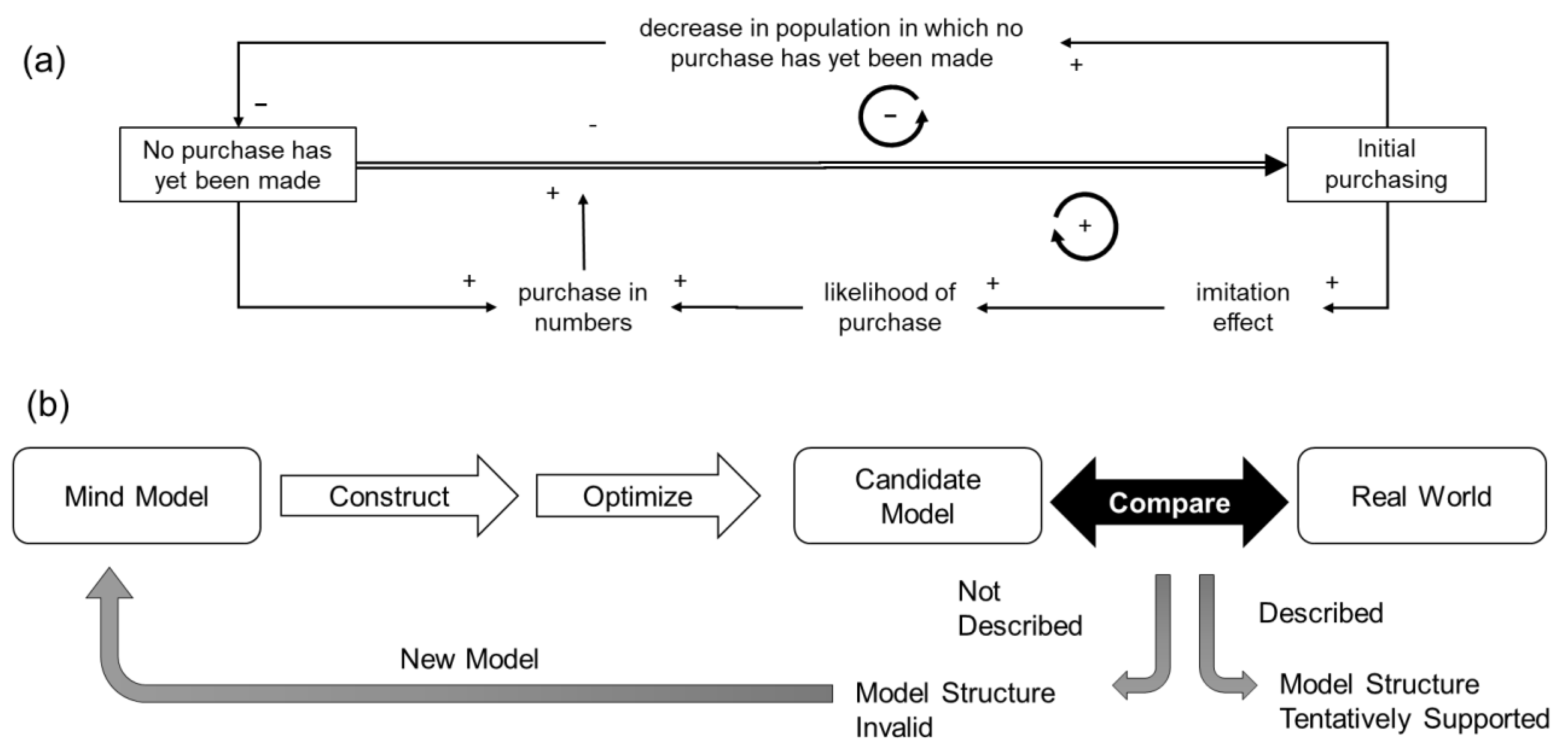

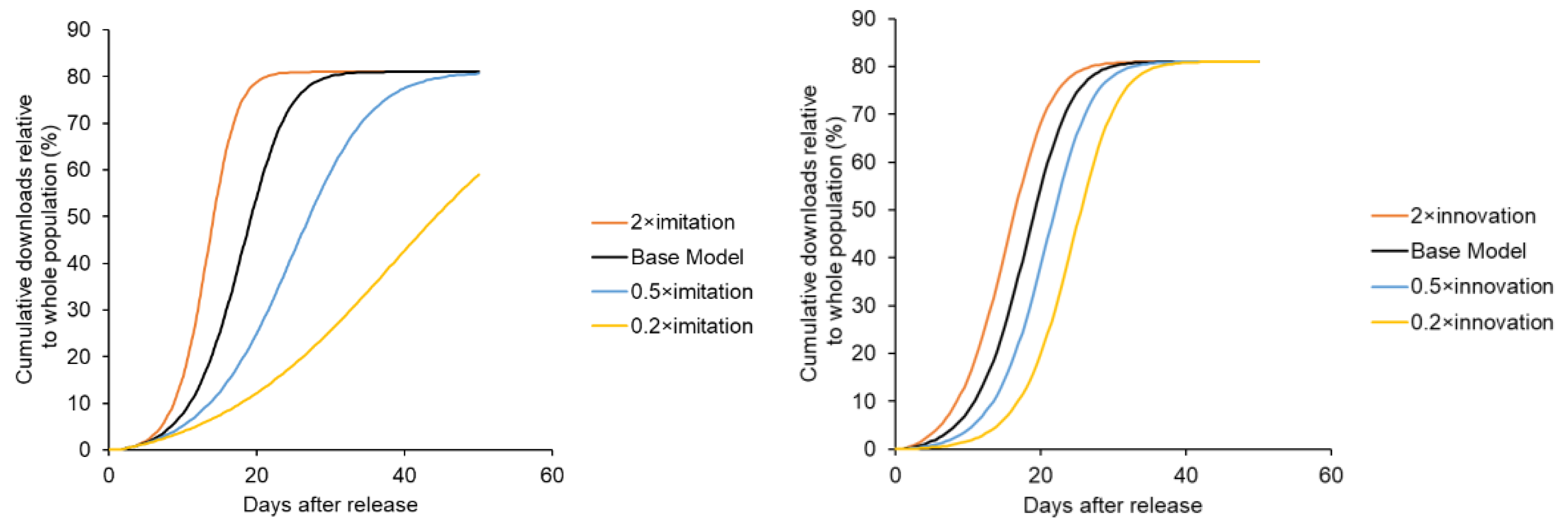


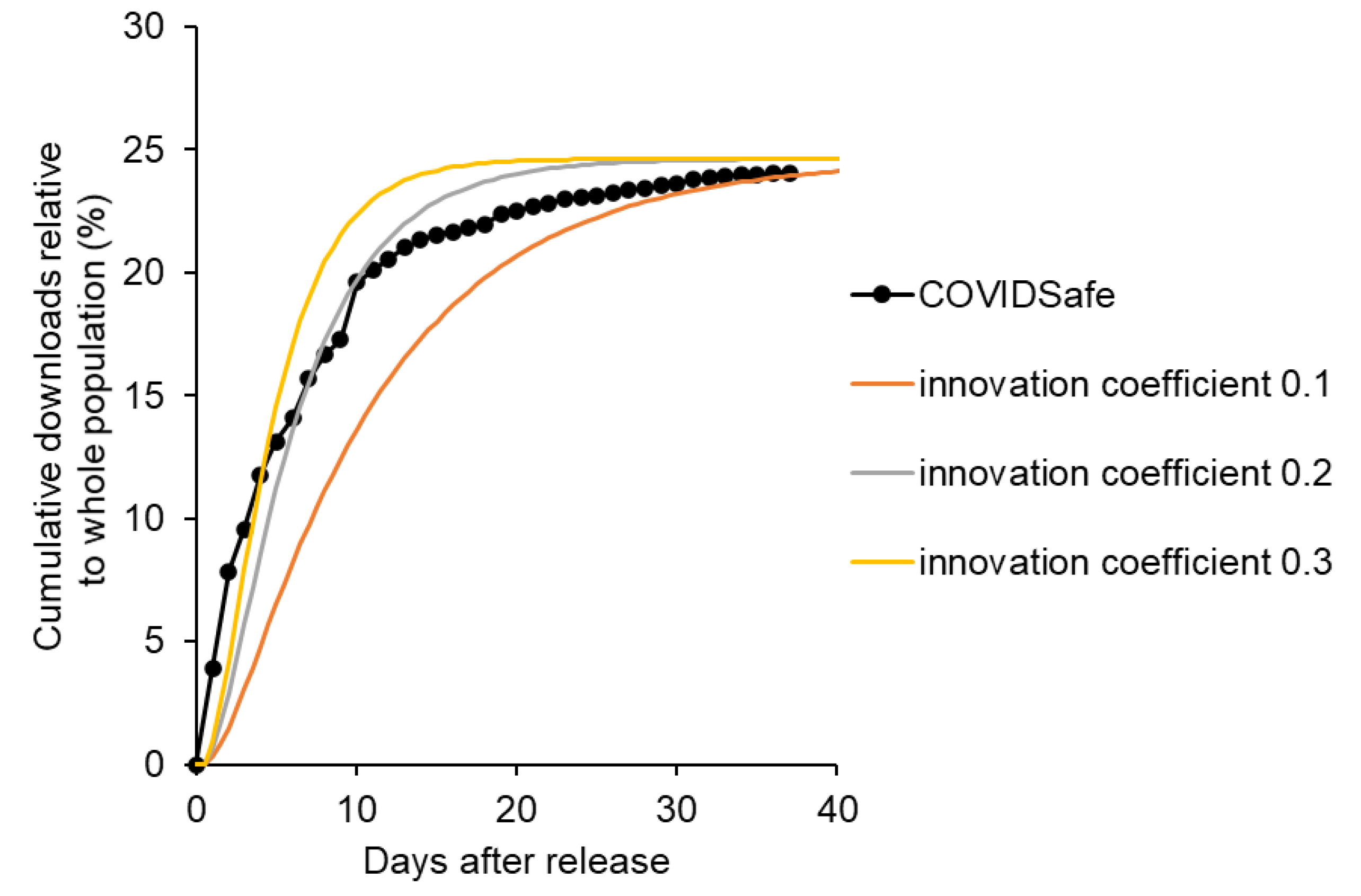



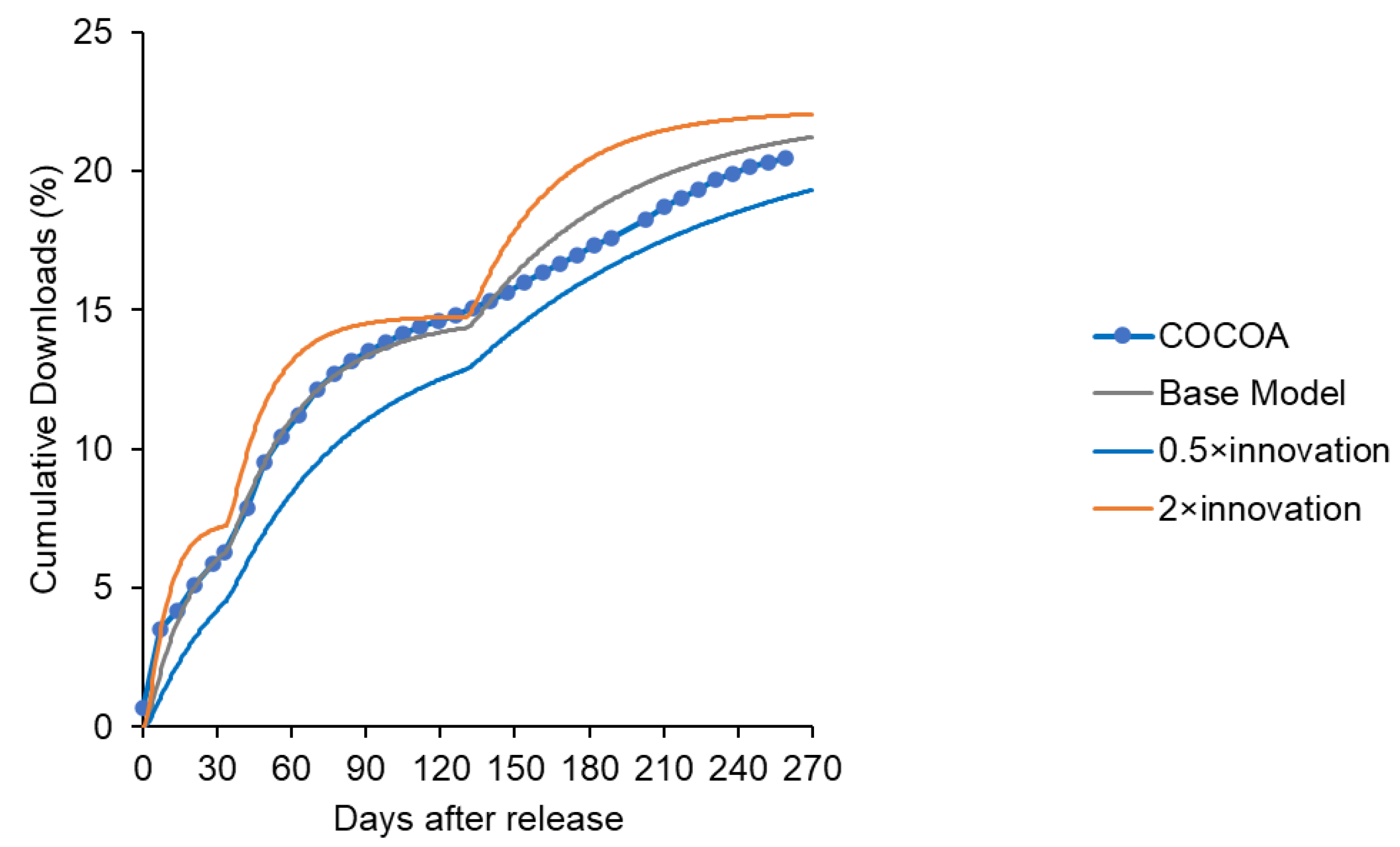
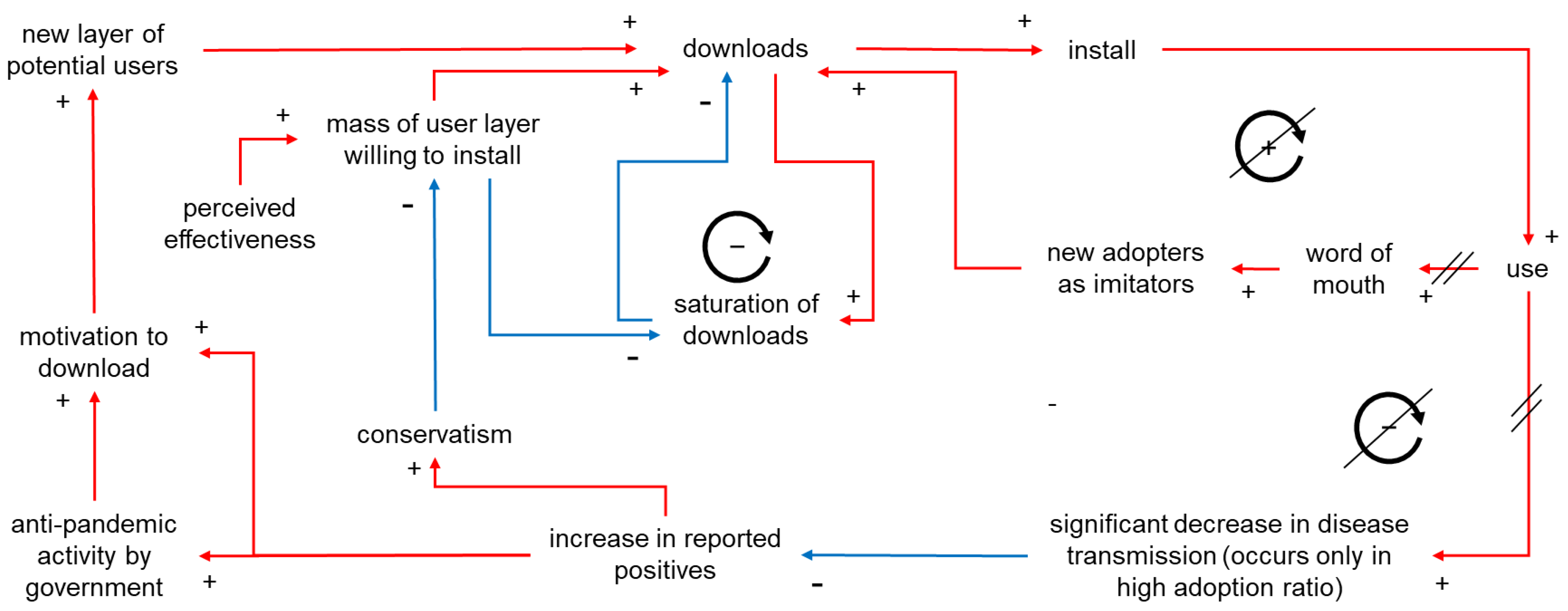
Publisher’s Note: MDPI stays neutral with regard to jurisdictional claims in published maps and institutional affiliations. |
© 2022 by the authors. Licensee MDPI, Basel, Switzerland. This article is an open access article distributed under the terms and conditions of the Creative Commons Attribution (CC BY) license (https://creativecommons.org/licenses/by/4.0/).
Share and Cite
Niwa, M.; Lim, Y.; Sengoku, S.; Kodama, K. A Layered Adopter-Structure Model for the Download of COVID-19 Contact Tracing Apps: A System Dynamics Study for mHealth Penetration. Int. J. Environ. Res. Public Health 2022, 19, 4331. https://doi.org/10.3390/ijerph19074331
Niwa M, Lim Y, Sengoku S, Kodama K. A Layered Adopter-Structure Model for the Download of COVID-19 Contact Tracing Apps: A System Dynamics Study for mHealth Penetration. International Journal of Environmental Research and Public Health. 2022; 19(7):4331. https://doi.org/10.3390/ijerph19074331
Chicago/Turabian StyleNiwa, Makoto, Yeongjoo Lim, Shintaro Sengoku, and Kota Kodama. 2022. "A Layered Adopter-Structure Model for the Download of COVID-19 Contact Tracing Apps: A System Dynamics Study for mHealth Penetration" International Journal of Environmental Research and Public Health 19, no. 7: 4331. https://doi.org/10.3390/ijerph19074331
APA StyleNiwa, M., Lim, Y., Sengoku, S., & Kodama, K. (2022). A Layered Adopter-Structure Model for the Download of COVID-19 Contact Tracing Apps: A System Dynamics Study for mHealth Penetration. International Journal of Environmental Research and Public Health, 19(7), 4331. https://doi.org/10.3390/ijerph19074331








